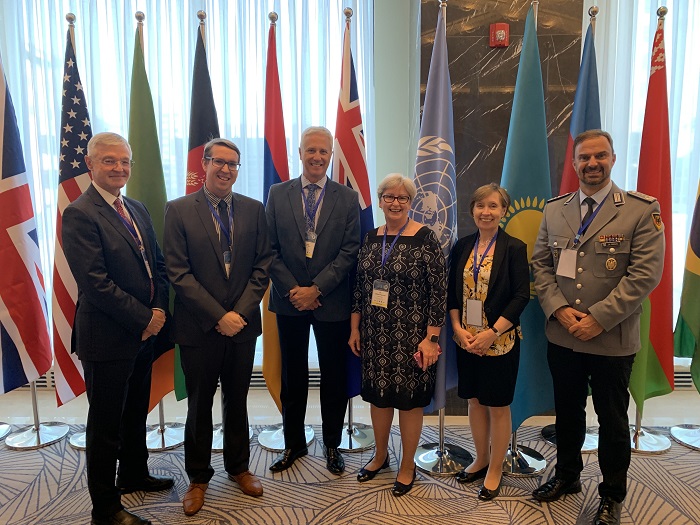Following his recent trip to Nur-Sultan, Kazakhstan, for the United Nations’ 5th International Partnership for Technology in Peacekeeping Symposium, Daniel Best from the Telehealth Support Unit reflects on the trip and how proud Queensland should be of its global standing:
“Back in March of this year Dr Jillann Farmer, Director, Division of Healthcare Management and Occupational Safety and Health, United Nations, asked if Queensland could send a delegate to the 5th International Partnership for Technology in Peacekeeping Symposium to share Queensland’s key achievements in telehealth. As a former director of patient in Queensland, Jillann knew of Queensland’s capability and high quality telehealth program.
What I didn’t know until I got there was that there is little to no use of telehealth in UN peacekeeping missions across the globe. The main issues being reliable IT infrastructure and a lack of clear clinical governance around who could provide the telehealth advice for these missions. My role, together with Dr Mark Elcock, Executive Director, Retrieval Services Queensland, was to discuss the key successes and failures of telehealth in Queensland and facilitate a series of plenary sessions and workshops on how telehealth could be better implemented in peacekeeping missions. We were joined by Ontario Telemedicine Network Canada and the University of Pittsburgh (USA).

PICTURED ABOVE: Telehealth Working Group, 5th International Partnership for Technology in Peacekeeping Symposium. From left to right; Dr Ron Poropatich, Mr Daniel Best, Dr Mark Elcock, Dr Jillann Farmer, Dr Karen Waite, Dr Stefan Goebbels).
Each of the telehealth representatives provided a presentation on different aspects of telehealth to the delegates. These included:
- Dr Ron Poropatich (University of Pittsburgh) presented on his 30 years’ experience in the U.S. Army and the use of telehealth in military situations. In his current role as Director of the Centre for Military Medicine Research, his team is researching autonomous CPR platforms utilising unmanned aerial vehicles.
- Dr Karen Waite (Ontario Telemedicine Network) presented on a whole of health sector approach to telehealth, where Ontario has been able to achieve a set of telehealth services available across primary, hospital, private and community care. They are now performing over one million virtual consultations each year.
- Dr Mark Elcock (Retrieval Services Queensland) presented on the extensive emergency telehealth services available across Queensland. Starting in 2006 with the implementation of videoconferencing in a single treatment room at Palm Island, with the intention to reduce risky over-water helicopter retrieval flights. Then in 2013 with the implementation of the Telehealth Emergency Management Support Unit (TEMSU) to provide rural facilities with low acuity advice from their nearest providing facility. Moving through to today, where there are over 160 facilities across Queensland that are now enabled to access vital specialist clinical and retrieval telehealth support for rural and remote healthcare staff in the management and coordination of critical and emergency care patients.
- I presented on the technology journey we have gone through in Queensland Telehealth over the last 13 years. I highlighted our transition to and maturing of videoconference technology in the early years from low-bandwidth telephone line-based calls to the high-definition internet-based service we provide today. From basic trolley mounted solutions to wall mount solutions with dual cameras, ceiling microphones and external connections for video-based medical devices such as ultrasounds and otoscopes. Outlining all the barriers, enablers and key lessons learnt throughout this journey. I finished by providing an overview of a range of emerging technologies that we are currently assessing for a range of new models of telehealth care.
After each presentation, a roundtable discussion occurred to better understand the needs and challenges for standardising the implementation of telehealth in all peacekeeping missions. Anecdotally, the main barriers were highlighted as being network reliability in extremely remote communities, clinician adoption, and clear pathways for receiving remote advice. It was generally agreed that telehealth could assist with reducing or providing more specialist care for the high number of risky and expensive medical retrievals performed by helicopter during peacekeeping missions.
These discussions resonated with our experiences and delegates were keen to learn more. They also saw similarities with Queensland primary healthcare centres due to their size, staff levels and network connectivity issues and how we have worked together to overcome these limitations.
This symposium was a fantastic opportunity to showcase Queensland’s telehealth journey and maturity on a world stage.”
Thanks to Dan for sharing! For more information on Telehealth visit their website.
Read more news or to keep up to date with Clinical Excellence Queensland, subscribe to our mailing list or follow us on Twitter or Facebook.